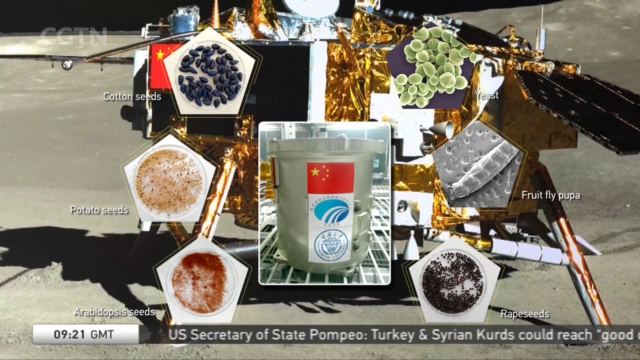
19:48, 13-Jan-2019
Chang'e-4 Lunar Mission: First ever biological experiment on far side of Moon
Updated
19:47, 16-Jan-2019
03:48

As we approach the 50th anniversary of man landing on the moon, a different group of living creatures has just arrived there. A team of scientists from Chongqing University has sent a small biological payload aboard the Chang'e-4 spacecraft. So what's in it? CGTN's Wu Lei has more.
It's been said that good things come in small packages. This small tin is not even 3 kilograms. But thanks to its installation on the lander of the Chang'e 4 spacecraft, it has made history. The tin is mankind's first biological payload on the moon. The six passengers inside? Seeds of cotton, potatoes, Arabidopsis、rapeseeds, fruit fly pupa and yeast.
XIE GENGXIN, CHIEF DESIGNER BIOLOGICAL EXPERIMENT PAYLOAD OF CHANG'E-4 LUNAR MISSION "There are animal, plants and microorganisms in this payload, creating a micro-ecosystem. We used a light pipe to guide the sunlight inside the tin, we will study their photosynthesis under strong sunlight."
The lunar environment features low gravity, bright sunlight and radiation. Professor Xie says the water inside the payload has been released, and the seeds will soon sprout.
WU LEI CHONGQING UNIVERSITY "To better understand how the plants and animals grow in different environments, scientists have set up two identical payloads which start simultaneously with the one on the moon. As we can see, one of the cotton seeds has already sprouted here on earth."
But how many will spring up on the moon still needs to be confirmed, with the latest images expected very soon. Professor Xie says one of the key challenges is to control and adjust the temperature within such a small area. They have tried many new materials and technologies. Researchers from Chongqing University are now monitoring the growth data 24 hours a day, and recording the latest condition accordingly. Since 2015, researchers and scientists from Chongqing University have brought this project from idea to reality.
LIU HANLONG, VICE PRESIDENT CHONGQING UNIVERSITY "This biological experiment payload was chosen from almost 300 projects nationwide. Professors and researchers from Chongqing led the way, but we also cooperated with researchers from over 20 domestic institutes and universities."
Many scientists around the world are wondering whether or not these plants and animals will pollute the lunar environment. Professor Xie confirmed that's impossible because the payload is sealed and they have taken every measure to prevent such a thing from happening.
XIE GENGXIN, CHIEF DESIGNER OF BIOLOGICAL EXPERIMENT PAYLOAD CHANG'E 4 LUNAR MISSION "As we know, no air nor oxygen exists on the moon, and the temperature is always very extreme (over 100 degree Celsius in the daytime and 180 degree Celsius below freezing at night). Even if some of them leaked, they would have no chance to survive, they would be decomposed to harmless organics with no pollution on the moon."
Regardless of the results, Professor Xie says the team has opened a new chapter in space experiments. After the project is finished, they will study the data carefully, summarize the experience and prepare for their next biological experiment. WL, CGTN. Chongqing.

SITEMAP
Copyright © 2018 CGTN. Beijing ICP prepared NO.16065310-3
Copyright © 2018 CGTN. Beijing ICP prepared NO.16065310-3